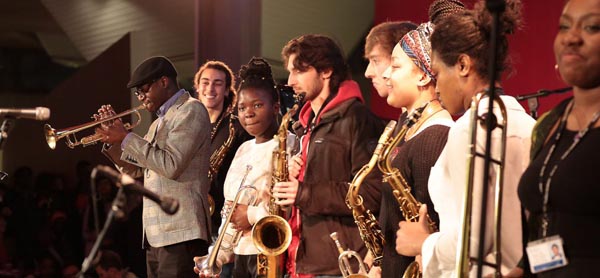
[The links on this page were correct when the item was included - please contact us if you find that any of them are no longer working]
Click here for ALBUM REVIEWS
Books Alphabetically By Author:
David Binns - Homes Of The Hits
Dave Gelly (Editor) - 30-Second Jazz
Peter Kerr - Don't Call Me Clyde
Peter King - Flying High: A Jazz Life And Beyond
Keiron Pim - Jumpin' Jack Flash (David Litvinoff and the Rock 'n' Roll Underworld)
Simon Spillett - Tubby Hayes - The Long Shadow Of The Little Giant - The Life, Work and Legacy of Tubby Hayes
Books Alphabetically By Title:
30-Second Jazz - Dave Gelly (Editor)
Don't Call Me Clyde - Peter Kerr
Flying High: A Jazz Life And Beyond - Peter King
Homes Of The Hits - David Binns
Jumpin' Jack Flash (David Litvinoff and the Rock 'n' Roll Underworld) - Keiron Pim
Tubby Hayes - The Long Shadow Of The Little Giant - The Life, Work and Legacy of Tubby Hayes - Simon Spillett
Performances Alphabetically by Title:
Tomorrow's Warriors Extraordinary Showcase 2017
Angra Jazz Festival 2017
Café Society Swing
Monty Alexander at Ronnie Scott's Club
Events Alphabetically by Title:
Miles Davis and John Coltrane at 90 - Retrospect and Prospect
Tomorrow's Warriors extraordinary Showcase 2017 |
Howard Lawes reviews the organisation's performances at the Royal Festival Hall's Clore Ballroom in December 2017.
In their 25th year (although some sources suggest they began in 1991) the Tomorrow's Warriors organisation and musicians who have passed through their development programmes have pretty much swept the board when it comes to awards and recognition of achievement in UK jazz. In the Parliamentary Jazz Awards, winners included Tomorrow's Warriors themselves for 'Jazz Education'; Nerija, Cleveland Watkiss and Shabaka Hutchins. Moses Boyd picked up a MOBO, Ezra Collective a UMA and co-founder Gary Crosby was presented with a BASCA award. Given the current success and up-beat predictions for the future careers of several Tomorrow's Warriors alumni anyone with an interest in spotting jazz stars of the future should surely have been at The Royal Festival Hall on a Sunday in December where the latest generation of up and coming jazz musicians were performing in the 25th Anniversary Extraordinary Winter Showcase.

After an introduction from artistic director Gary Crosby and a brief but informative film about learning with Tomorrow's Warriors, the music kicked off with the Junior Band which had Gabriel Jones on alto saxophone, Dominic Abrokwa on trombone, India Pascal on piano, Ygor Querino on double bass and JR Carlyon on drums. Members of the Junior Band are typically early teens with experience of playing jazz ranging from a few weeks to a couple of years. All of them played really well with some intelligent soloing but at the end of their set they disappointingly just wandered off stage without really acknowledging the audience. Next up was a group of older musicians, generally Gary Crosby's mates, who played a very nice set including requests from the audience. A couple of younger musicians joined in, William Wood playing a mean tenor saxophone and Ezra Collective member Dylan Jones on trumpet.
Click here for a video of the Ezra Collective playing Enter The Jungle live at at Sofar, London in 2016.
The Tomorrow's Warriors Youth Ensemble consists of older teenagers and early twenty year olds with several years experience and some really impressive expertise. The music was introduced by drummer Cassius Cobson and the band started with Inner Urge, Donovan Haffner ably adopting the Joe Henderson role; There Will Never Be Another You had Joseph Oti playing trumpet in this tune popularised as a jazz standard by Chet Baker and Maddy Coombes added a swinging solo on tenor saxophone. A tremendous version of the Sonny Rollins classic Oleo had a great conversation going on between guitarist Francisco Garcia de Paredes and drummer Cassius Cobson and this very talented band, with Jonah Grimbley on piano and Jaques Jervis on double bass, finished off with Nothing Personal composed by Don Grolnick and featured on saxophonist Michael Brecker's debut album.
During the extended interval many of the young players amused themselves by jamming together in the Green Room and it was a joy to see and hear these really talented young musicians relishing the opportunity to play together as they do most weekends in the practice rooms of the Royal Festival Hall where Tomorrow's Warriors have been resident since 2009. Talking of really talented young musicians it was great to see Moses Boyd who dropped in to help celebrate the anniversary. Moses came through the Tomorrow's Warriors scheme about 10 years ago when they were based at the Spice of Life in Soho. Now he is enjoying a great deal of success as a professional musician leading the current 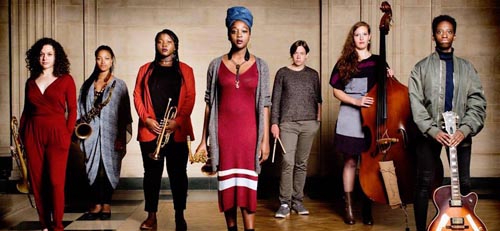 surge of young UK jazz musicians who are making a huge impact at the moment. In those earlier days there were less students than there are now but the same friendly, supportive environment was fostered by the tutors which Moses found so helpful.
surge of young UK jazz musicians who are making a huge impact at the moment. In those earlier days there were less students than there are now but the same friendly, supportive environment was fostered by the tutors which Moses found so helpful.
Nerija
The second part of the showcase began with another film about a Tomorrow's Warriors initiative called The Jazz Ticket which is a schools-based music education project that brings together young musicians from across the UK to work with leading jazz professionals on a set of specially arranged compositions marking anniversaries of the birth of some really outstanding jazz musicians.
Click here to watch The Jazz Ticket film (5 minutes).
After the film, music was provided by the Tomorrow's Warriors Female Frontline, an all female band emphasising one of Tomorrow's Warriors founding principles which is to encourage female participation in the music industry. This band is led by alto saxophonist Aleksandra Topczewska and includes young women aged between 15 and 22 playing a varied programme that began with the song Crazy Race by trumpeter Roy Hargrove, sung by the two vocalists Kasia Kawalek (who also plays flute) and Loucin Moskofian, with Lettie Leyland on trumpet. Miles Davis' Jam Session from the Dingo film and album provided great opportunities for improvising solos supported by the rhythm section of Roella Oloro on piano, Nia Tilli on double bass and Alana Curtis on drums. Maddy Coombes stood out with her tenor saxophone. The next number was Red Clay by Freddie Hubbard, featuring trumpet and piano and the set concluded with Strasbourg Saint Denis, another composition from Roy Hargrove that highlighted Jelly Cleaver on guitar and Oyin Ogunjobi on bass clarinet.
Click here for a video of the Female Collective band playing live in 2017.
The grand finale of the day was a performance of The Nutcracker Suite by Tchaikovsky, arranged by Duke Ellington and Billy Strayhorn, performed by the Tomorrow's Warriors Youth Orchestra directed by Binker Golding. If anyone needed any further convincing of the quality of both the tutors and students within the Tomorrow's Warriors stable then this classic piece of music provided it. This really is a major piece that any orchestra would find both challenging and gratifying. As the suite is for a jazz, rather than a classical orchestra, there is more emphasis on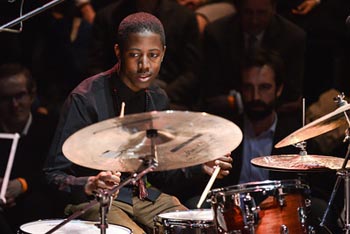 rhythm, brass and woodwind than strings. Unlike some other jazz arrangements of classical music the solos last for just a few bars, nevertheless pianist Jonah Grimbley, saxophonists William Wood and Maddy Coombes, Oyin Ogunjobi on bass clarinet, Mebrakh Johnson on clarinet and Zoe Pascal on drums demonstrated their virtuosity and the whole orchestra with Binker Golding ably conducting produced a great performance that was warmly applauded by the enthusiastic audience.
rhythm, brass and woodwind than strings. Unlike some other jazz arrangements of classical music the solos last for just a few bars, nevertheless pianist Jonah Grimbley, saxophonists William Wood and Maddy Coombes, Oyin Ogunjobi on bass clarinet, Mebrakh Johnson on clarinet and Zoe Pascal on drums demonstrated their virtuosity and the whole orchestra with Binker Golding ably conducting produced a great performance that was warmly applauded by the enthusiastic audience.
Moses Boyd
This was a wonderful day that clearly demonstrated the wealth of talent within the Tomorrow's Warriors organisation, both on stage and in the background. Founders Gary Crosby and Janine Irons have rightly received much acclaim for their foresight in setting up the original music education and artist development programme and also for their continued enthusiasm that has seen their creation become a National Portfolio Organisation of Arts Council England. Clearly success breeds success for Tomorrow's Warriors, and while the music industry can seem like a mountain to climb, the young musicians on view today are gaining that huge advantage which Moses Boyd found so useful as he developed his career.
Angra Jazz Festival 2017 |
Filipe Freitas at JazzTrail tells us about his visit to AngraJazz Festival.
The 19th AngraJazz, which happens on the beautiful Terceira Island in the Azores, Portugal, ran from October 4th through 7th with renowned artists and a cozy, friendly atmosphere. The beautiful Centro Cultural e de Congressos de Angra do Heroísmo, a former bullfight ring transformed into a cultural center, was the stage for seven packed performances that brought the thrills of jazz in its most varied shapes to both unconditional devotees and occasional listeners of the genre.
For the very first time, the main event was complemented with ‘Jazz na Rua’, a program featuring jazz performances from Portuguese groups at smaller venues around the city. Joining the local bands, Wave Jazz Ensemble and Sara Miguel Quartet, was Mano a Mano, a guitar duo composed of the brothers Bruno and André Santos, who took the opportunity to introduce their new album Mano a Mano Vol.2
DAY 1, Oct 4
ANGRAJAZZ ORCHESTRA
On Wednesday, the local big band AngraJazz Orchestra opened the festival with 13 renditions of classic tunes composed/recorded by unavoidable jazz giants such as Thelonious Monk, Dizzy Gillespie, Tadd Dameron, Ella Fitzgerald, and Lena Horne (each one of them celebrating his/her centennial), plus the one-and-only big band wizard Duke Ellington.
Danish-born, Lisbon-based maestro Claus Nymark, who shared the musical direction with the Portuguese tenor saxophonist Pedro Moreira, conducted a collectively solid band that kicked in with Dameron’s “Lady Bird”, but insisted more on the Monk’s music. They embarked on a melodically sparse interpretation of “Bemsha Swing”, a warm harmonization of “Round Midnight”, a collective fun take on “I Mean You”, a slightly more conservative exposition of “Let’s Cool One”, and an ambitious arrangement of “Epistrophy”. Vocalist Sara Miguel lent her voice to a handful of tunes, including the celebrated “Honeysuckle Rose” and “Sweet Georgia Brown”, here shaped with the swinging verve and effusive arrangements popularized by Ella.
BAPTISTE TROTIGNON & MININO GARAY
For the second act of the night, we had an eclectic duo composed of the French pianist Baptiste Trotignon and the Argentine percussionist Minino Garay. Blending South American dynamics and a sophisticated straight-ahead jazz, the pair crafted a few interesting moments, mostly based on pieces from their 2016 album Chimichurri. The indefatigable rhythmic wallops of the pianist, left and right, attained an impeccable synchronization with the percussionist’s versatile manipulations.
After describing how the duo met in Buenos Aires, where both were playing at a jazz festival with their respective groups, Garay announced the beautiful tango “Sus Ojos Se Cerran”, a composition by Carlos Gardel that earned a few enthusiastic ‘bravo’.
Many of the extended tunes acquired forms of lyrical chants and unconfined rambles, here and there flavored with the suaveness of the bolero or the hasty propulsion of the Brazilian choro. Still, one of the most impactful moments of the well-received concert happened when Trotignon, exploring the broad tonal range of his instrument, veered into bluesy balladry and played a solo medley initiated with “The Nearness of You”.
DAY 2, Oct 5
CHARLES TOLLIVER TENTET
Also with Monk’s centennial in mind, the Charles Tolliver Tentet attempted to reenact the pianist’s historic 1959 Town Hall concert, but wasn’t so successful as many would expect, stirring mixed feelings with an uneven performance, the only one scheduled for Thursday, October 5th. Veteran pianist Kirk Lightsey, filling in for the first announced Stanley Cowell (absent due to prolonged illness), started the concert with a rubato solo rendition of “In Walked Bud”. A few minutes later, bassist Devin Starks and drummer Darrell Green joined him to redefine “Blue Monk”. The trio was then expanded into a quartet with the addition of tenor saxophonist Stephen Gladeney, who designed “Rhythm a Ning” with a fervent articulation.
The remaining members of the tentet thickened up the sonic textures from this point on, already under the direction of bandleader/trumpeter Charles Tolliver, who only picked up the trumpet once for a brief improvisation. While the adventurous alto saxophonist Todd Bashore and trumpeter Josh Evans reinforced the pungent first line of the horn section, the baritone saxophonist Patience Higgins, tuba player Aaron Johnson, and trombonist Stafford Hunter were entrusted with the deep-toned embellishments. Some tunes worked better than others, and the sheer intensity of “Thelonious” (featuring notable solos by Bashore and Evans) or the arresting, improvisation-less “Crepuscule with Nellie”, opposed to the not so effective celebrations of “Off Minor” or “Little Rootie Tootie”. The uncommunicative Tolliver, whose back was constantly turned to the audience, only introduced the musicians during the brisk closing tune, “Trinkle Tinkle”.
DAY 3, Oct 6
ENSEMBLE SUPER MODERNE
The Portuguese 8-piece Ensemble Super Moderne was in charge of the first set on Friday night, becoming a confirmation for the ones already familiar with their modern arrangements and personal sound, as well as a fantastic surprise for the ones (like myself) who were probing their music for the first time.
The band has José Pedro Coelho on tenor sax, Rui Teixeira on baritone sax and bass clarinet, José Soares on alto sax, Paulo Perfeito on trombone, Eurico Costa on guitar, Carlos Azevedo on piano and synth, Miguel Angelo on bass, and Mario Costa on drums.
For their liberal conception, sonic layering, and timbral variety, the tunes were effectively absorbed, with the following deserving a special mention: “Modern”, an ingenious waltz adorned with succinct 4/4 swinging passages, sounded great for a detective story (Philip Marlowe style); “The Dreary Life of Pugnacious Cacti” conveyed a biting wit through an early collective cacophony but embraced noir-ish tones as soon as the bassist started his personal statement; and “Regui”, a piece that accentuates the contagious Jamaican groove at the same time that opens space for the profound intonations of the baritone and the wild gusts of the drummer.
MATT WILSON QUARTET
Brandishing all the genuine humor and outgoing posture that characterize his drumming and compositional style, the great Matt Wilson didn’t disappoint, providing a truly vibrant performance. He led a majestic quartet whose in-demand members are respected bandleaders themselves: longtime collaborator Jeff Lederer on tenor saxophone and clarinet, Kirk Knuffke on cornet, and Chris Lightcap on acoustic bass.
“Arts & Crafts”, featuring Lederer’s improvisational euphoria, immediately and unequivocally demonstrated the power, unity, and pliancy of the group.
Butch Warren’s “Barack Obama” came next, illuminated by a stunning bass solo upfront and thriving with sparking horn movements over the refined brushwork of the bandleader.
Whether soloing individually or immersed in concordant polyphony, Lederer and Knuffke always achieved a winsome poise when exteriorizing ideas, regardless the contrast observed in their approaches.“Raga”, a piece from 2003, spread strong Oriental aromas in the room, serving as a showcase for Wilson’s inventive and highly expressive percussive techniques. In addition to the shakes, clangs, gongs, and mallet drumming employed here, the drummer stunned everyone when employing hip-hop snare drum scratches on “Man Bun”, a rock-inflected composition that reminded me of “Blister in the Sun” by Violent Femmes. Before that, Jon Irabagon had borrowed Lederer’s tenor to embark on a singular 3-horn blues ride with a rendition of “Pee Wee’s Blues”.
Wilson’s deep fondness of poet Carl Sandburg’s work was mirrored not only on the recent “Choose” (from his latest CD Honey and Salt), a military-like march packed with a sturdy avant-garde grip and striking improvisations, but also on “Bubbles”, a composition from 2012 in which he recited the poem of the same name. They closed the set with the exuberant rhythmic transitions and melodic transparency of “Thespian”, a piece written by the hard-bop pianist Freddie Redd. The attendants’ faces reflected satisfaction in what was the most balanced, and probably strongest day of the festival.
DAY 4, Oct 7
YILIAN CAÑIZARES QUINTET
The last day opened with the Cuban singer/violinist Yilian Cañizares, whose quintet features Daniel Stawinski on piano, David Brito on contrabass, Inor Sotolongo on percussion, and Cyril Regamey on drums and percussion. The positive energy, noble socio-political intentions, and musical generosity of the bandleader were totally recognized, yet the music, inhabiting a more accessible corner of the jazz spectrum, didn’t have a significant impact on me. Mostly drawing from her 2014 album, Invocación, and embracing a somewhat saccharine, mellow tone, Ms. Cañizares warmed the public with “Cancion de Cuña Para Dormir a un Negrito”, a tune based on the known poem by Cuban Luis Carbonell, “Donde Hay Amor”, a love song dedicated to her late grandfather, “Iya Mi”, a faded Latin pop exercise sung in Yoruba, and “Mapucha”, an anti-sexism tune featuring a zealous percussion juncture. Despite the talented musicians, I noticed a lack of peak moments and emotional crescendos throughout the performance, a fact that didn’t hamper a myriad of enthusiasts from cheering vehemently.
JON IRABAGON QUARTET
Closing the festival in a memorable way, the Jon Irabagon Quartet delighted the ones searching for strong emotions with tunes from the albums Behind the Sky and the upcoming Dr. Quixotic’s Traveling Exotics (due out early next year), as well as a couple of takes on American jazz classics. Backed by consolidated artists such as pianist Luis Perdomo, bassist Yasushi Nakamura, and drummer Rudy Royston, Irabagon plunged into different jazz currents with the usual expansive posture and that incredible kicking sound that once was part of Chicago, and now often colors the New York jazz venues.
They kicked in with “One Wish”, a melodious combination of soulful post-bop artistry and pop balladry that naturally evolved into swinging motion during the section reserved for improvisation. On “Sprites”, after the staggering and occasionally polyphonic sax intro, we found the musicians responding to one another until Irabagon’s romping solo has been placed over the half-step minor chord changes of “Impressions”. Following the extrovert spontaneity of the bandleader, Royston explored drum sounds with unrestrained inspiration. A brand new jazz funk piece entitled “Emotional Physics” brought an effervescent “All The Things You Are” attached on its wings, while the ballad “Music Box Song” cooled down the room with its softer rhythmic constitution, but offered up, in turn, a fantastic bass solo filled with expressive slides and constructive plucks.
The quartet closed the 19th AngraJazz with “The Cost of Modern Living”, a dancing piece where the soul-jazz of Eddie Harris meets the Latin impulses of Joe Henderson. It was noticeable how Nakamura and Royston were having fun, especially after doubling the tempo to accommodate Perdomo’s solo. From behind the drum kit, Royston engendered another colossal intervention for a majestic finale. Everyone seemed euphoric and touched by the quartet’s modernistic charms.
Being my first time attending the festival, I was well impressed with the fantastic organization, the quality of the selected lineup, and the attentiveness of an enthusiastic audience that encompassed people of all ages.
Miles Davis and John Coltrane at 90 - Retrospect and Prospect. |
A conference at the University of Surrey from 21st to 23rd October 2016 was hosted by the University's Department of Music and Media. Howard Lawes tells us about it:
This conference of thirty presentations was primarily for musicologists and those academics who have spent a great deal of time listening to jazz in general and Miles Davis and John Coltrane in particular. For the layman it was a real education to come to realise that not only are many jazz solo improvisations transcribed, which can be done manually or by using sophisticated computer software, but that the music of all the other 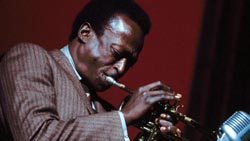 musicians playing simultaneously with the soloist is also transcribed and that conversations between musicians in the band can then be implied.
musicians playing simultaneously with the soloist is also transcribed and that conversations between musicians in the band can then be implied.
However as well as these highly skilled and time consuming tasks, other academics have considered the social, cultural and political significance of these iconic American music heroes and hearing about their research was equally as fascinating as the mechanics of the composition, arrangement, direction, performance, recording and marketing of the music.
As well as talking about music, attendees at the conference and jazz fans from the local area were treated to a mini jazz festival with performances from the Gary Crosby quintet, Notes Inegales, the Ronnie Scott's All Stars quintet and the Steve Waterman quartet; in addition to this Steve Waterman led a workshop for local musicians and there was a showing of the film Miles Ahead. All of this took place on the Guildford campus of the University of Surrey, looking splendid with its golden, autumn colours and making use of the excellent facilities of 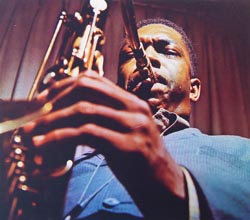 the Music Department which has been ranked #1 for music by the Guardian in its 2017 University Guide. There were too many presentations to review every one but to provide a flavour of what was discussed at the conference a few snippets are as follows:
the Music Department which has been ranked #1 for music by the Guardian in its 2017 University Guide. There were too many presentations to review every one but to provide a flavour of what was discussed at the conference a few snippets are as follows:
On day one Professor Ingrid Monson from Harvard described Davis and Coltrane's formative years as ones of 'civil unrest, artistic conviction and political engagement' and that both men 'helped define idealised qualities of Blackness that shaped an alternative universal to Eurocentric understandings of musical genius'. But it wasn't just Davis and Coltrane who were great, their band members were too and Dr. Brian Levy explored the harmonic and rhythmic interactions that become clearer once each musician's contribution has been transcribed.
In the same vein but using computer instead of manual methods, Dr. Wolf-Georg Zaddach from the University of Music 'Franz Liszt', Weimar, presented results from his analysis of many famous jazz solos (results available on-line) comparing Coltrane with other saxophonists influenced by him such as David Liebman and Michael Brecker, while saxophonist John O'Gallagher has analysed late Coltrane improvisations to show them to be not as free as some commentators have suggested, but highly structured.
Professor Tim Wall from Birmingham focused on the late Miles Davis album, Tutu, and the creative partnership with Marcus Miller. Day one ended with a conversation, recorded for BBC 3, between broadcaster Alyn Shipton and Tomorrows Warriors 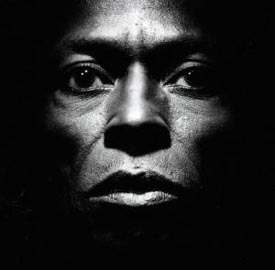 artistic director Gary Crosby followed byperformances of Kind Of Blue with Mark Kavuma (trumpet), Denys Baptiste (saxophone), Benet Mclean (piano), Gary Crosby (double bass) and Romarna Campbell (drums) and then A Love Supreme with Wakili Eddie Hick taking over the drums and Denys Baptiste producing an absolutely outstanding performance of the Coltrane classic.
artistic director Gary Crosby followed byperformances of Kind Of Blue with Mark Kavuma (trumpet), Denys Baptiste (saxophone), Benet Mclean (piano), Gary Crosby (double bass) and Romarna Campbell (drums) and then A Love Supreme with Wakili Eddie Hick taking over the drums and Denys Baptiste producing an absolutely outstanding performance of the Coltrane classic.
Miles Davis Tutu
The second day of the conference opened with some practice-based sessions from Jeremiah McDade and Dave Morgan from MacEwan University, Brian Levy from the New England Conservatory and Milton Mermikides from the University of Surrey. Professor Tony Whyton from Birmingham City University considered the representation of Davis and Coltrane in jazz history while Alyn Shipton and Dr. Marc Medwin from American University, Washington discussed the impact of Coltrane's seminal album Ascension on later, free jazz and modern avant-garde classical music. Noting Davis's lack of direction to his band members, a very interesting presentation was given by Peter Wiegold of Club Inegales assisted by trumpeter Torbjorn Hultmark and guitarist Joel Bell demonstrating the use of signals to direct members of an ensemble.
Jonothan Stockdale, University of Wesminster, considered some technical aspects of the recording of Kind Of Blue and in particular creating intimacy in the huge space that was 30th Street Studios in New York by the use of acoustic baffles. The conference dinner was followed by a performance from the Ronnie Scott Allstars; with Alex Garnett (saxophone), Freddie Gavita (trumpet), James Pearson (piano), Matt Burgess (double bass) and Chris Higginbottom (drums); of great jazz tunes from 1959, "The Year That Changed Jazz". Famous jazz standards such as So What, Giant Steps, Peace, Better Git It In Your Soul, Time Out and Take 5, Sister Sadie from Davis, Coltrane, Horace Silver, Charles Mingus, Dave Brubeck, Bill Evans and Ornette 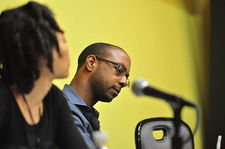 Coleman were reeled off by a group of superlative musicians to a full house in the acoustically excellent Ivy Arts Centre.
Coleman were reeled off by a group of superlative musicians to a full house in the acoustically excellent Ivy Arts Centre.
Elliott H Powell, University of Minnesota
The third and final day of the conference started with more analysis of aspects of the Davis brand of music; Dr Garrett Michaelson from Umass Lowell highlighted the rebelliousness of some band members whose unexpected contributions resulted in a unique variety of "anti-music", Jason Balzarano considered the fusion of styles in Davis's Bitches Brew album and some of the confusion that exists over genre labelling, Elliott Powell from the University of Minnesota considered the sociological and cultural messages that can be implied from the cover of Miles's controversial On The Corner album, Pedro Cravinho from the University of Aveiro and Birmingham City compared Davis's interaction with event organisers when he first visited Portugal in 1971. This was during a period of political conservatism and 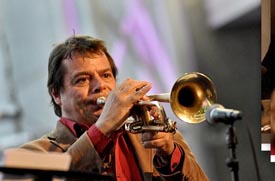 political unrest in Portugal's African possessions and then later in 1991 when, with a more liberal regime, Davis was treated like a pop star.
political unrest in Portugal's African possessions and then later in 1991 when, with a more liberal regime, Davis was treated like a pop star.
Steve Waterman
Performance events included a workshop led by trumpeter, Steve Waterman, which introduced mostly young members of Guildford Jazz to the modal style of soloing prevalent on Kind Of Blue and a concert by the Steve Waterman Quartet entitled "Tribute to Miles" that included many favourites such as Freddie Freeloader, Boplicity, Four, Blue On Green and Tutu with Waterman on trumpet (using Harman mute), Gareth Williams on piano, Marianne Windham on double bass and Clark Tracey on drums. The playing as would be expected from such an illustrious ensemble was exquisite. The final event was a showing of the recently released film Miles Ahead starring Don Cheadle and Ewan McGregor which was definitely not the high point of the conference but still worth a look for fans of the ongoing Miles Davis story.
In summary this was a very well structured conference with presentations from many, eminent musicologists from the USA and Europe about the amazing music and historical impact of two iconic, American heroes. Many compliments have been paid to Jeremy Barham of the University of Surrey who organised the conference with the help of Guildford Jazz and about the excellent facilities which are available at the university. What seems to have made it stand out for the lucky conference attendees was the wonderful combination of expert, academic analysis, lively converstion and outstanding musicianship that was exhibited by the bands who played for them - all round a thoroughly enjoyable experience.
Howard Lawes
Peter Kerr - Don't Call Me Clyde |
Publisher: Oasis-WERP / Kindle (27 May 2016) - Reviewed: September 2016
Subtitled 'Jazz Journey Of A Sixties Stomper' Peter Kerr's book is an enjoyable read, descriptive and informative. It is not just about his time with the Scottish born band The Clyde Valley Stompers but a picture of the times. Growing up in East Lothian, the young Peter Kerr had a father who in the words of his wife was 'a poor imitation of a ham-fisted pub piano player', but Peter Kerr the elder was happy doing just that, and to play the accordion too whenever he could get his hands on one.
It was Peter's friend Derek who suggested that he and Peter learn to play the bagpipes, it was free, although they had to do out of school work to save for the practice chanter (melody pipe). Once again it was Derek who introduced them to the Dixieland B-side of a Theresa Brewer record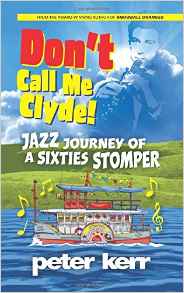 and then the movie The Benny Goodman Story. 'If Barney Bigard's playing with Satchmo had hooked me on the instrument, Benny Goodman's stunning clarinet artistry hauled me in ... I'd have to get myself a clarinet.' Family friend Fergus had an opinion on jazz musicians: 'He'll end up dead in the gutter ... Prostitutes and rotgut booze. Way of life in that game. The pox and cirrhosis of the liver ... always ends the same.'
and then the movie The Benny Goodman Story. 'If Barney Bigard's playing with Satchmo had hooked me on the instrument, Benny Goodman's stunning clarinet artistry hauled me in ... I'd have to get myself a clarinet.' Family friend Fergus had an opinion on jazz musicians: 'He'll end up dead in the gutter ... Prostitutes and rotgut booze. Way of life in that game. The pox and cirrhosis of the liver ... always ends the same.'
Peter's description of his school days leads into the 'Jazz Revival' of the late '50s, his discovery of wider jazz influences, gig nights at the Haddington Corn Exchange and his introduction to the Clyde Valley Stompers band: 'It transpired that, with over thirteen hundred punters piling into Haddington's Corn Exchange, the Clyde Valley Stompers had smashed yet another attendance record.' Meanwhile Peter gets a job as a civil servant in Edinburgh, forms his first band with the Hidden Town Dixielanders with friends Jim Douglas, 'Wee Bob' Sandie, Kimber Buglass and Jack Blair and with them travels to London for the Carroll Levis Discoveries programme (that early version of Britain's Got Talent) and an opportunity to visit the London jazz clubs.
Back in Edinburgh the band was 'taking up more and more of our time' and hanging out at the city's jazz venues brought them increasingly into contact with other bands and musicians, some of whom began to play with the band. A couple of recordings were released with the band name changing from the 'Hidden Town Syncopators' to 'Pete Kerr's Dixielanders', but Pete and the others were still juggling everyday work with their music and he describes well how musicians have to balance their playing with work that brings in money - and then the situation when the offer of a residency on the Continent comes along - the response of employers, parents and other band members. The opportunity seems too good to miss - until the residency ends, and then 'What Am I Gonna Do Now?' as an earlier chapter heading asks.
It was 1961 and Pete describes the circumstances where he was re-introduced to the Clyde Valley Stompers, now called Ian Menzies and the Clyde Valley Stompers, or more affectionately 'The Clydes'. His audition and then time with the band, touring, personnel changes, the 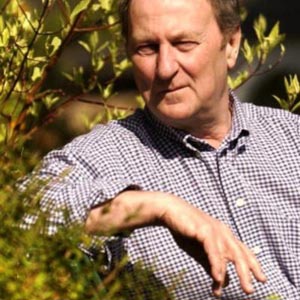 responsibility of leading the band, the business and 'political' implications, etc. that take up the following chapters will ring bells for many musicians and bands. The success of 'hit' recordings like their jazz version of Prokofiev's Peter And The Wolf is described both in its making and the resulting popularity and then as Pete says: 'Being busy can be a breeze, as long as everything's running smoothly, but it doesn't take much to turn a breeze into a hurricane. And ill winds have a habit of not turning up singly, as I was about to find out ....'
responsibility of leading the band, the business and 'political' implications, etc. that take up the following chapters will ring bells for many musicians and bands. The success of 'hit' recordings like their jazz version of Prokofiev's Peter And The Wolf is described both in its making and the resulting popularity and then as Pete says: 'Being busy can be a breeze, as long as everything's running smoothly, but it doesn't take much to turn a breeze into a hurricane. And ill winds have a habit of not turning up singly, as I was about to find out ....'
Click here for a video of the Clyde Valley Stompers playing Peter And The Wolf in 1962.
At a time when 'pop' music was becoming increasingly prevalent, the jazz interpretation of classical pieces could become a two-edged sword with accusations of 'selling out'. Balanced with the expectations of managers, the issue of contracts and royalties and personal health issues and the change of band name to Pete Kerr's All-Stars, again give a reflection of the time, the business, the life of a jazz musician / bandleader, and Pete Kerr's story places them all well.
Pete Kerr
Click here for details of the book.
Ian Maund
Peter King - Flying High: A Jazz Life And Beyond |
Publisher: Northway Publications (20 Jan. 2014) - Reviewed: August 2016
In his review below, Jamie Evans was both exhilarated and saddened by the autobiography of British alto saxophonist, Peter King:
Although his book was published five years ago, I only recently got round to reading it and regret it took me so long.
First let me declare my interests. I have quite a lot in common with Peter King. We were both born at the beginning of World War II, brought up in humdrum family circumstances in the South London/Surrey region. We have both been troubled by addiction problems over the years although Peter massively more so than myself. We both made our own faltering attempts to copy the music of our jazz heroes by listening and copying in 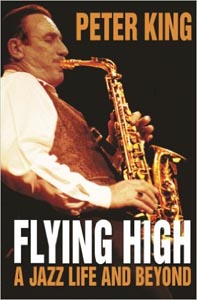 the days when jazz tuition was rare and college courses were never even contemplated.
the days when jazz tuition was rare and college courses were never even contemplated.
The resemblances end, of course, with the fact that Peter went on to become a world-class jazz saxophonist and I pottered about in an enjoyable role as a run-of-the-mill, semi-professional, mainstream pianist.
Enough, and now on to the real interest - alto saxophonist and renowned aero-modeller, Peter King. His life has been one of great extremes - an immense musical talent which unfortunately led into a downward spiral of chronic narcotic addiction which he courageously recounts. A travel phobia and a disastrous early marriage to Joy, were other ordeals he suffered.
Like most sax players Peter started with a simple system clarinet after being bowled over as a teenager by the grossly distorted Hollywood biopic, The Benny Goodman Story. Well, everyone starts somewhere and Peter kicked off in a South London pub, sitting in with a dixieland outfit and playing Ice Cream in Bb, a tune he didn’t know, but he received an encouraging reception. He progressed by being shown “hieroglyphics” by the banjo player. These were, of course, chord symbols.
Peter’s Damascene revelation, like so many modern jazz musicians was hearing Charlie Parker. The experience blew his mind and from then on, listening to the top players of the day, he acquired an alto sax and progressed to actually playing with top names like Don Rendell, Jimmy Skidmore, Harry Klein, etc.
Click here to listen to Peter King soloing on Lush Life.
The real acid test came when he shared the stand with Tubby Hayes, at the time the acknowledged “guv’nor” on the British scene. Little was said by Tubby but later Peter heard that the Great Man had been favourably impressed. Another rite of passage had been negotiated and, one could say that the crowning point of his youthful apprenticeship while still a teenager, was to be invited to open a new venture, Ronnie Scott’s Club, in October 1959.
Peter, unlike some others of the jazz fraternity, was introduced to taking a “joint”, which he thoroughly enjoyed. Unfortunately that was to lead to one of the most calamitous aspects of his life.
He was becoming well known to all the top British musicians. Playing regularly at Ronnie’s and hearing the procession of US visitors, usually sax 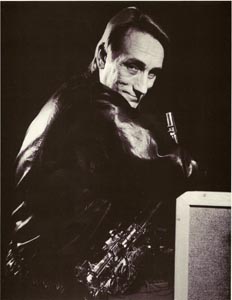 players, broadened his style and technique. A spell in John Dankworth’s big band felt to him like a final year at university where he gained lots of experience in sight-reading and section playing.
players, broadened his style and technique. A spell in John Dankworth’s big band felt to him like a final year at university where he gained lots of experience in sight-reading and section playing.
In 1961, another high spot in the King early days was hearing one of his great heroes, pianist Bud Powell, at a German jazz festival. Bud had a history of deep mental illness and frightened off many gestures of friendship with offensive and odd behaviour.
Peter specifically went to hear Bud in a Parisian club where only a handful of punters had turned up and was scared of getting a mouthful of abuse from the pianist. However all went well when he sat in and was thanked with broad smiles and a handshake. It seemed Bud was impressed by “the spotty-faced, 21-year-old from England who sounded like Bird.”
Unfortunately an enjoyable “joint” progressed to a full-blown heroin habit and much of his early life was occupied with finding dealers or doctors who would prescribe narcotics to registered addicts. The dreadful withdrawal symptoms which users experience became a fearsome event.
The drug habit persisted for many years although with such a massive talent he still produced sublime music although like many top-class players he had to supplement meagre gig money with more mundane work to pay the bills. Fortunately, his later marriage to Linda helped him through the many years of addiction and he attributes both his survival and success as a musician very much to her love and support. He was desolated by her death a few years ago.
There are some fascinating jazz anecdotes contained in the book.
One of his heroes, Ben Webster, who thought nothing of drinking three bottles of the hard stuff a day, alternating gin, whisky and vodka, was entertained at Peter’s parents’ place in Tolworth. Ben was treated to a traditional English roast dinner and was lost in gratitude.
On holiday in Majorca, Peter and Linda frequented a bar where Ron Rubin played solo piano. Another piano player, an American called Art Simmons used to come and play a bit as well. One night Linda, who had been a fair singer in the past, was persuaded to take the stand and sang a few tunes accompanied by Art who loved her voice. She nearly fainted when they told her that Art had been Billie Holiday’s accompanist.
On another occasion, a promoter with strange taste had booked Peter and former Charlie Parker trumpet man, Red Rodney, for a gig. The piano player turned out to be Art Hodes, a fine musician but more of a boogie expert. They all bit their lips like real pros and did the job playing 12-bar blues.
Looking back over a long career there so many great achievements in the King story.
In 2003 he finished many years of hard work writing an opera Zyklon, in collaboration with writer Julian Barry, based on the life of the Jewish scientist Fritz Haber who unknowingly helped invent the substance used for the mass murder of his own people by the Nazis (650 pages of fully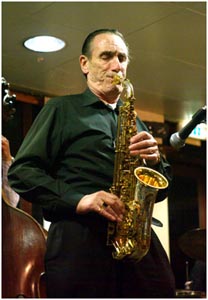 orchestrated score). Ironically the premiere was in New York where as a young hopeful he had hoped to establish his name as a jazz musician not as an opera composer.
orchestrated score). Ironically the premiere was in New York where as a young hopeful he had hoped to establish his name as a jazz musician not as an opera composer.
He has played all over the world and received a Lifetime Achievement Award in Russia, an honour not reciprocated in his own country. Peter also had the honour of playing Bird’s plastic Grafton alto in a Kansas City celebration.
Click here for Peter playing Kaper's Invitation with the Orquestra do Algarve in 2011.
Peter King
Photograph courtesy of Brian O'Connor (imagesofjazz.com)
My own interest in Peter King commenced one Saturday night in the Bull’s Head, Barnes, many years ago. I had heard this British alto player in various media but never live. He took the stand and launched into one of his favourite Wayne Shorter tunes, Yes Or No. With his regular drummer and pianist, Steve Keogh and Steve Melling, in full chase behind him, I could hardly believe my ears. In my long life playing and listening to top jazz performers, American, British and other, this was something very special - the searing tone, the impeccable technique and the endless flow of ideas.
I knew nothing of Peter’s addiction at that time and I am sure he had been clean for a long while but his gaunt, sad face bore the signs of a harrowing past. It was an evening of pure joy and I repeated my visit to Barnes whenever I could and I can only thank Peter King for the immense pleasure he has given me and many others over decades of listening.
Click here for a video of the Peter King Quartet at Jamboree Jazz.
Many autobiographical works often contain score-settling elements. But there is an almost total absence of these and Peter is continually surprised at the “niceness” of people he encounters - sometimes characters with reputations of being temperamental or difficult. Perhaps it hasn’t occurred to him that being such an obviously nice man himself, even the most mean-spirited human being could only reciprocate in kind?
This review only scratches the surface of an immensely interesting and enjoyable read and I would urge anyone who loves music - Bartok (Peter’s favourite “straight” composer) or Bird - to buy it.
Click here for details of Flying High.
Jamie Evans
Jamie Evans manages a website remembering the late clarinettist Alan Cooper - click here.
David Binns - Homes Of The Hits |
Publisher: David Binns (2015) - Reviewed: 2015
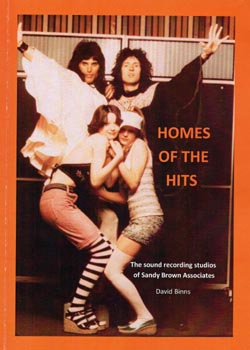
There are those who will not know, or who might have forgotten, that apart from being a clarinettist and bandleader, Sandy Brown was also a top acoustic architect. Initially working at the BBC, he went on to set up Sandy Brown Associates with his business partner, David Binns. The company is still in business although David has now retired.
David has now written a book, Homes Of The Hits, that looks back over the sound recording studios that Sandy Brown Associates set up or were involved with between the years of 1965 to 2004. It contains some fascinating information that would be of interest to people who are involved in the recording industry as well as anecdotes about musicians who were involved in the projects. Those who know about Helios desks, Ampex recorders and JBL 4350s will find things for them. For others stories are told of setting up studios for Paul McCartney and Eric Clapton, the Rolling Stones mobile studio and the Sheffield Brothers' Trident studios, although there are other tales and the studio project for Ginger Baker in Lagos takes some beating.
Freddie Mercury and Brian May in Trident Studios
Ginger Baker did not seem bothered by the cost. The desk and studio electronics were built in England and shipped out to Africa. ''My first visit was with Ginger and was my first 1st Class flight to Lagos,' writes David Binns. 'I arrived early at Heathrow and waited in the First Class Lounge: waited and waited, long after the flight was called. If Ginger was going to miss the flight I thought that I should go, sat down and strapped in. At the very last moment, just as the doors were shutting, there was a commotion and Ginger arrived and sat down next to me, stony faced ... It transpired that Ginger had been visited at home the previous day by the drug squad. Fela Ransome Kuti, a friend of Ginger's ... had sent a young American with a drum packed with hash to sell in London. He was stopped at the airport and arrested. When asked who he had come to see he panicked and said Ginger Baker.' The story continues to recount the difficulties setting up a studio in a corrupt Africa, Ginger's contacts with Fela Kuti and the surprise that Paul and Linda McCartney had when they arrived to record there with their band Wings. 'Paul and Linda didn't know that Nigeria was run by a gun-happy military government, the result of a coup several 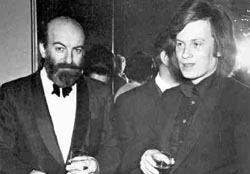 years earlier,or that many parts of the capital city had open sewers and lepers walking the streets.'
years earlier,or that many parts of the capital city had open sewers and lepers walking the streets.'
'Sandy decided that even the beer and ice were suspect and stuck to large scotches with sealed bottle water - until one glass turned black as the waiter filled it. From then on he forced down straight scotch accompanied by sharp intakes of breath and coughing fits.'
Sandy Brown and David Binns
Homes Of The Hits is a 99-page softcover book that talks about twenty-one studios that the company were involved in setting up and six that 'got away' including studios for The Beatles and Richard Branson. Some chapters are quite short, others longer with more anecdotes and the text is accompanied by many photographs of musicians from the time as well as pictures and diagrams of the studios and equipment. Some of the studios included are those of Denis Preston and Lansdowne Studios; Bob Auger and Pye Studios; Eric Stewart and Strawberry Studios; Giorgio Moroder and Musicland Studios and George Martin and Air Studios, Lyndhurst.
Only 150 copies of the book have been printed and unfortunately it appears that a un-proofed copy went to the printers, so there are a number of 'typos' in the text. Despite this, it is an interesting account. It is only available direct from David Binns at £11.00 (including postage and packing) email: david.binns@zen.co.uk.
Dave Gelly (Editor) - 30-Second Jazz |
Publisher: Ivy Press (2016) - Reviewed: March 2016
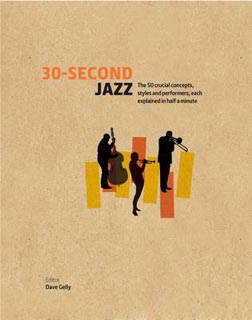
Sub-titled 'The 50 crucial concepts, styles and performers, each explained in half a minute', Dave Gelly's 160 page, hard-backed book 30-Second Jazz published by Ivy Press at £14.99 in February 2016 attempts quite a challenge.
Who is it for? The book cover suggests it is for jazz 'non-aficionados' and 'novices'. "For its initiates, jazz is instinctive and engaging - the way that popular music should be. For non-aficianados, it can be slippery and difficult to grasp: without familiarforms or a hard-and-fast format, and largely ruled by improvisation, jazz leaves the novice baffled, not sure how to listen, and asking 'how is it they know what to play?'"
The book is split into different sections. Each section has centre-piece text 'The 30-Second Jazz' written by well-respected writers from the jazz community. Following Dave Gelly's Introduction, Brian Priestley deals with The Shape Of Jazz introducing styles, band formats, language and then Chris Parker summarises a section on Instruments Of Jazz. Dave Gelly provides a compact section on Vocal Jazz and Charles Alexander introduces 8 Classic Jazz Albums. Jazz and the Blues is compiled by Tony Russell and the sections conclude with Today Is The Question from Kevin Le Gendre.
Within each section is a Profile of a particular musician: Duke Ellington; Charlie Parker; Louis Armstrong; Ella Fitzgerald; Miles Davis, B.B.King and Craig Taborn, and there is a Glossary of Terms at the start of each 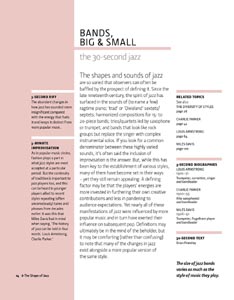 section. There is then a short Appendix section with selected books, websites and Festivals listed as 'Resources', notes on the contributors and an Index.
section. There is then a short Appendix section with selected books, websites and Festivals listed as 'Resources', notes on the contributors and an Index.
Between these pages a large amount of information is covered in short bursts. Each item is allocated one page (The Profiles have two pages). In the centre, the '30-Second Jazz' description. I was able to read this in 30 seconds as long as I didn't try to absorb what was being said. To the left of the page is a '3-Second Riff', a short sentence / paragraph summarising the item followed by '3 - Minute Improvisation', a strange heading as it took no longer to read than the '30-Second Jazz' piece, but I found the facts shared in these paragraphs particularly interesting. To the right of the page we have 'Related Topics' (a 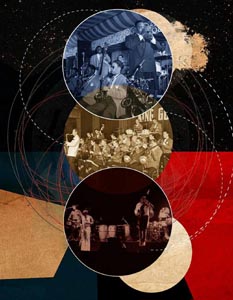 cross-reference to other topics in the book); '3-Second Biographies' where three musicians are named to illustrate the topic; and below that in bold print a comment on the topic.
cross-reference to other topics in the book); '3-Second Biographies' where three musicians are named to illustrate the topic; and below that in bold print a comment on the topic.
Click here and then on the various pages to see the layout.
The illustrations on almost every facing page (and that is a lot of illustrations) are impressive, striking collages, almost worth framing individually, and with the hard cover, this is almost a coffee-table book.
If we acknowledge that the concept of jazz can be difficult, a brief explanation / description needs to be simple without being condescending. I shared the book with two 'non-aficionados' and asked for their impressions. The first said that the Introduction went 'straight over her head' and that she found the structure of the book confusing - 'I would have found it easier to grasp as a timeline'. The second felt that too much information had been attempted in too small a space and that he came away with just a list of musicians in his head.'
For 'non-aficionados' and 'novices' it could be a good reference book, perhaps starting by reading The Shape Of Jazz chapter and then using other pages as a base-camp for setting out to research the other topics although a novice reader would be jumping between styles if they listen to all the recommendations made in each item. That is not necessarily a bad thing, as long as you don't think that because this is a 30-second concept, you are going to absorb everything quickly.
With any publication, it has to stop somewhere. Dave Gelly explains that the book only takes 'snapshots' of what is happening in 'the second decade of the twenty-first century', and the 8 Classic Jazz Albums only cover albums from 1938 to 1989 on the basis that the recording quality was poor in earlier decades and 'not enough time has elapsed to ensure classic status since 1989' for later releases. With any book summarising 'Jazz' it inevitably has the potential to leave out things that people might think should have been included. Dave Gelly can't win on this one, I think.
Click here for details.
Ian Maund
Keiron Pim - Jumpin' Jack Flash (David Litvinoff and the Rock 'n' Roll Underworld) |
Publisher: Jonathan Cape (2016) - Reviewed: March 2016
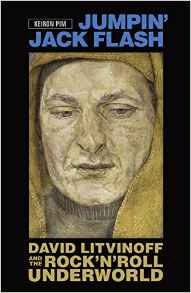
David Litvinoff was a Soho character and inventor of the Chelsea Set in the1950s, 1960s and early 70s. He was a well-known figure in the jazz clubs, nightclubs, gambling dens and after-hours drinking clubs of those days. In his time he managed to straddle with ease the jazz world, emerging rock ‘n’ roll / rhythm & blues, the art world, show business, bohemians, homosexual scene (“gay” hadn’t yet come into use), high life and low life! It seems that singlehandedly he broke down the class barriers of post-war Britain and created a melting pot, mixing together all these factions into one overlapping whole.
Born David Levy in Bethnal Green, he changed his name to Litvinoff, in line with his two half-brothers and his mother’s second husband, partly because Litvinoff sounded more interesting and partly because it sounded more Jewish! He liked to flaunt his Jewishness (and homosexuality, even though this was still illegal) and would approach strangers on the street yelling “I’m just a crazy mixed-up Yid…”
Being a denizen of Soho at that time, I do actually have “through-a-mist” impressions / memories of David Litvinoff, and surely we must have rubbed shoulders (or, more probably, derrières) jiving the sweaty nights away amongst the heaving bodies at Cy Laurie’s in Ham Yard, Upper Windmill Street (a place I have written about previously - click here). I went on those Aldermaston 'Ban The Bomb' marches, attended the opening of The House of Sam Widge, another of David Litvinoff’s haunts, and was acquainted with many of the characters mentioned in this book: for instance, Iron Foot Jack who one summer evening in 1957 regaled me with fantastic tales down the Gyre & Gimble Coffee House in John Adam Street, off the Strand. He wrote out my horoscope (cost: one shilling) which, spookily, came true, even to the date of my future marriage!
Another friend (via my jazz connections) was George Melly who, in his autobiography Owning Up, said of Litvinoff “he was the fastest talker I ever met, full of outrageous stories, at least half of which turned out to be true, a dandy of squalor, a face either beautiful or ugly, I could never decide which, but certainly one hundred percent Jewish, a self-propelled catalyst who didn’t mind getting hurt as long as he made something happen, a sacred monster, first class”.
There is a photograph on page 45 of the book showing Litvinoff, sporting short shorts and a busby, leading the Soho Fair Parade of 1955. In the marching band following along (which has to be the Omega Brass Band), I spy Mac Duncan on trombone and Ian Wheeler on clarinet, both members of Ken Colyer’s Jazzmen, the earthily authentic New Orleans band of this era.
Long before the Swinging Sixties, we knew Soho when Carnaby Street was merely a dreary thoroughfare of blind shopfronts, the only open eye being Vince Man’s Shop displaying one shirt in the centre of a small window. But enough of my self-indulgent nostalgia (the memories come flooding in): what is shocking about this biography is how it reveals Litvinoff’s connections with the underworld, e.g. Jack (Spot) Comer, the Krays, Charlie Richardson, etc. It puts one in mind of the Roaring Twenties, the Jazz Age: America during the years of Prohibition when the Devil’s music and the soft underbelly of the gangster world collided in a deathly embrace!
Litvinoff was a frustrated genius, a shape-shifter, a Fagin with his gaggle of street urchins, a manipulator, and would do anything to 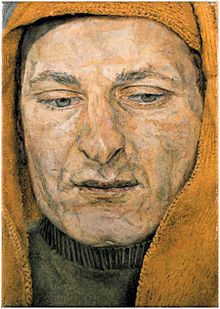 please - or annoy: something the Krays frowned on. Evidently David Litvinoff was, at heart, kind and generous, yet could switch and indulge in casual cruelty just for a laugh – or for gain: “I’m a dangerous person!” he said. Always on the lookout for the main chance, he was living “on the cusp of art and criminality” with no visible means of support.
please - or annoy: something the Krays frowned on. Evidently David Litvinoff was, at heart, kind and generous, yet could switch and indulge in casual cruelty just for a laugh – or for gain: “I’m a dangerous person!” he said. Always on the lookout for the main chance, he was living “on the cusp of art and criminality” with no visible means of support.
George Melly said “he never slept that I was aware of” which could be attributable to DL’s Benzedrine habit and could also explain the way he was constantly reinventing himself, full of mad ideas: David Litvinoff was a performer, he was his own conceptual art exhibit – “to try to capture David’s personality is rather like trying to net a butterfly”.
We learn all about DL’s relationship with Lucien Freud and their falling out, possibly over the portrait of Litvinoff which Freud had entitled “The Procurer”. Well yes, Litvinoff was a procurer and not only of runaway lads for Ronnie Kray but also anything anyone wanted – “ask David and he’ll get it for you”.
Man In A Headscarf (originally The Procurer) by Lucian Freud
So, he was a thief, a shoplifter, a torturer, a curator (of people), a philosopher, a storyteller, a writer “who didn’t write”, a passionate muso, an artiste, but also a dialogue coach and technical adviser! Which brings us to the making of Performance, Mick Jagger’s first film (click here for the trailer). David Litvinoff had an ear for dialect and accent, having replaced his cockney tones by listening to Laurence Olivier’s recordings of Shakespearean roles. A section of the book is devoted to the ins and outs of this film and how the storyline was based on real-life gangland happenings, either witnessed by Litvinoff or participated in as victim (as he often was) or perpetrator (likewise) ...
However, the Krays, who were in prison by this time, let it be known they did not approve of their personal doings being displayed for all to see in a film, so DL hot-footed it to Wales, taking refuge in a cottage called Cefn-Bedd, in Llanddewi Brefi (later made famous in BBCTV’s Little Britain’s recurring sketch “The Only Gay In The Village”) where he embraced the country life and took to wearing a farmer’s smock or just his birthday suit!
Many were the famous people who beat a path to Cefn-Bedd: Bob Dylan (was it really him?), Eric Clapton, the Rolling Stones, John Lennon and Yoko Ono, Jimi Hendrix, etc. etc, but when word got around of Litvinoff's “secret” whereabouts and it seemed his cover might be blown, he upped and left for Australia where he sojourned in Sydney amongst the artists of The Yellow House and participated in the making of a documentary, Sunshine City. With only three years of his life left to live, he returned to the UK in 1972, sadder but not wiser and, as usual, relying on the kindness of friends.
In this hefty tome, Keiron Pim takes us from David Litvinoff’s background, his parents’ flight from the Ukraine, to Litvinoff’s birth in 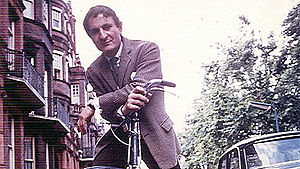 1928 and through to his death in 1975 by his own hand - “probably just before he would have been murdered” – via the grainy, crepuscular ‘50s, coruscating ‘60s and jaundiced early ‘70s in between.
1928 and through to his death in 1975 by his own hand - “probably just before he would have been murdered” – via the grainy, crepuscular ‘50s, coruscating ‘60s and jaundiced early ‘70s in between.
David Litvinoff
The book, which is in turn humorous and horrifying, took five years of Keiron Pim’s life to painstakingly research and is packed with detail from over one hundred interviews from the likes of Eric Clapton, Marianne Faithfull, James Fox, David Litvinoff’s family members, actors, directors, musicians, artists, old school friends, ex-gangsters and members of the nobility.
Keiron Pim wasn’t born until several years after these events took place but, in the opinion of one who was there, he has pinned down with obsessive passion the atmosphere and intensity of Soho and Chelsea and the crazy post-war creativity of those times. Whether you remember them or not, I urge you to wallow in this utterly fascinating and shocking treasure trove of a book. It is an important record of social history, and I, for one, look forward to seeing it being made into a feature film … if it is - I wonder who should play the role of David Litvinoff?
Click here for more details about Keiron Pim's book.
June Bastable
June Bastable is the wife of the late jazz musician, Johnny Bastable. She is a writer and author of two books Some People and These People available from Amazon, Waterstones, etc.
Tubby Hayes - The Long Shadow Of The Little Giant - The Life, Work and Legacy of Tubby Hayes |
Publisher: Equinox Publishing Ltd (2015) - Reviewed: December 2015
It is that time of year. Walk into any branch of Waterstone's or W.H. Smith and there laid out on a table inside the door are the biographies and autobiographies. The ideal Christmas present.
Simon Spillett's biography of Tubby Hayes came out a few months ago, but it still deserves its place on those tables. To say it is comprehensive is an understatement. If you combine it with 100% Proof: The Complete Tubby Hayes Discography published by Names and Numbers (click here and click on 'New Books') the new 240 page discography covering sessions for commercial album release, radio broadcasts, television appearances and private recordings made between 1951 and 1973, you probably have  the most extensive information about the saxophonist around. The discography also includes an overview of Tubby Hayes's film soundtrack work.
the most extensive information about the saxophonist around. The discography also includes an overview of Tubby Hayes's film soundtrack work.
Saxophonist Simon Spillett must be one of the most knowledgeable people around on Tubby Hayes. In the introduction to his book, Simon tells of the moment when he watched a video of the Tubby Hayes Big Band recorded by his father when Tubby appeared on BBC2's Jazz 625 series: 'As we sat and abosorbed the music, Dad gave me a sort of precis running commentary; Hayes was a virtuoso, who died very young, but who was the best modern jazz musician we'd got back in the 1950s and '60s, right up there with the American saxophonists. "We used to see him at Ronnie Scott's," he went on. "He'd be by the bar and always nodded a hello." .... 'Watching Tubby and his band on Jazz 625 that Sunday, I could have little dreamed how he and his music would affect the course of my life, or indeed that I would eventually get to know and work with four of the players I was listening to.'
Tubby Hayes died in 1973 at the age of thirty-eight. Simon's decision to write a biography was inspired by a number of things - his enthusiasm for Tubby's music, his surprise that 'no one had at yet written at length about him' and his belief that Tubby deserved better than the usual pat summary that 'went something like "boy wonder multi-instrumentalist goes to America, comes home triumphant, gets hooked on drugs, undergoes heart surgery and dies on the operating table, a tragic victim of the jazz life.'
And so Simon's very readable book, all 377 pages, including an exhaustive index and discography, unravells the story behind Tubby Hayes with a good scattering of photographs to illustrate the various stages of the man's life. There is the description of the cutting of modern jazz recordings in the 1950s, Tubby's association with trumpeter Jimmy Deuchar, the journey to New York and his linking up with Zoot Sims and meeting with Sonny Rollins, his problems with addiction and the two final chapters 'The Beginning Of The End' and 'It'll Be Me Next' where Peter King is quoted as saying: 'He'd obviously got in a cab, came to see us and made a special trip. There was something about his demeanour, that we kind of had the feeling that was the last time we wer going to see him. He had a kind of resignation about him.'
There can be no question about the thoroughness of Simon Spillett's research, there is much here that charts the times of jazz in the UK through Tubby's lifetime, and the book is enhanced by anecdotes that add to the picture of Tubby Hayes. By way of example, Simon quotes trumpeter Ian Hamer who recalls: "Tubby would bring the band off at the end of a number by swinging his sax down, like sax players do. Anyway, one night he'd had a bit to drink, and at the end of the tune, he brought his sax up and when it came down it slipped off the neck strap and went crashing onto the floor. There were bits and pieces everywhere. So he could carry on, Jack Sharpe lent him his tenor and the next thing you know, he did it again on the next number. I can remember the two of them out the back in the interval, trying to make one good sax between the two. It was hilarious."
The Long Shadow Of The Little Giant is a book to enjoy and to be thankful for. It is currently available from Amazon at £19.99 (click here).
Click here to watch the Tubby Hayes Big Band playing In The Night on Jazz 625 with Tubby on flute..
Ian Maund
Café Society Swing - April 2016 |
Alex Webb's Cafe Society Swing is a becoming established as a popular occasional feature in the UK jazz gig calender. Howard Lawes went along to find out what it is all about:
Cafe Society Swing won rave reviews for its New York run over Christmas 2014. Cafe Society was a cabaret club opened by Barney Josephson in Greenwich Village, New York in 1938. The format of the club was based on the "Kabarett" clubs in Germany which presented political satire as well as music and dance and it is ironic that as Josephson was opening his club in New York, the clubs in Germany were being closed down by the Nazi Party. The Christopher Isherwood novel Goodbye to Berlin and the Kander and Ebb Broadway musical Cabaret relate the events of the period in Germany.
Josephson opened Cafe Society Uptown in 1940 in Manhattan. Josephson's clubs were the first in New York (and probably in the USA) to welcome both black and white audiences to the same shows - "I wanted a club where blacks and whites worked together behind the footlights and sat together out front" he is quoted as saying. The clubs were well known for supporting new talent and many up and coming singers, jazz musicians, dancers and comedians played there, but they also presented established stars such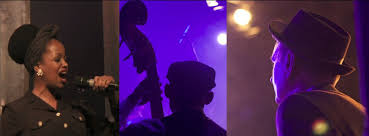 as Billie Holiday, who was a regular performer. After World War 2 Josephson's brother Leon fell foul of the House Committee on Un-American Activities and the subsequent publicity had a drastic effect on the popularity of Cafe Society forcing them to close in 1948, just 10 years after opening.
as Billie Holiday, who was a regular performer. After World War 2 Josephson's brother Leon fell foul of the House Committee on Un-American Activities and the subsequent publicity had a drastic effect on the popularity of Cafe Society forcing them to close in 1948, just 10 years after opening.
This brief piece of American history has been encapsulated by English jazz pianist, songwriter, journalist and academic Alex Webb into a musical diary called Cafe Society Swing in which Webb acts as pianist and narrator leading a distinguished band with Frank Griffith on tenor sax and clarinet, Nathaniel Facey on alto sax, Sue Richardson on trumpet, Nathaniel Cross on trombone, Miles Danso on double bass, Ciyo Brown - guitar and Shane Forbes on drums. Ciyo Brown and Vimala Rowe provide vocals.
The show starts with a couple of instrumentals followed by eighteen songs with each song highlighting a particular performer at the 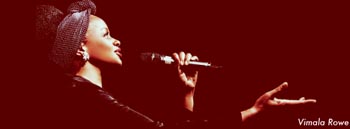 club. Between each piece of music the narrator relates the chronology of the club, provides social comment about the society of the time which is sometimes poignant, sometimes humorous. The story is fascinating and the music evocative of the period.
club. Between each piece of music the narrator relates the chronology of the club, provides social comment about the society of the time which is sometimes poignant, sometimes humorous. The story is fascinating and the music evocative of the period.
The musicians provide an effective big band sound which is great to listen to, the singers play their parts with Vimala Rowe having the lioness's share. Some of the first set highlights were One Meatball with Brown on guitar and vocals supported with a lovely muted trumpet solo from Richardson while Rowe sang Rock Me in the style of Sister Rosetta Tharpe - which really had the audience bouncing - and the highly entertaining Wild Women Don't Have the Blues in the style of Ida Cox. The band played a great version of the Count Basie classic, I Left My Baby.
In the second set Rowe took on the mantle of Sarah Vaughan with What Is This Thing Called Love while Brown's Lush Life, commemorating the fact that Billy Strayhorn was a regular visitor to the club was very good. The classic Billie Holiday number Strange Fruit, in true Cafe Society style was the finale with no encore. Vimala Rowe produced a fantastic rendition of this song and bringing great applause from the audience.
Cafe Society Swing is being performed again at the Sage, Gateshead in April and Hideaway, Streatham in May. It is well worth going along for an informative and highly entertaining night out.
Click here for a video clip from the show.
Howard Lawes (April 2016)
Monty Alexander at Ronnie Scott's Club - June 2016 |
It has been a while since Jamie Evans visited Ronnie Scott's club in Soho. He gives us his impressions going back there again in May to hear pianist Monty Alexander:
Until now, the last time I entered Ronnie Scott’s world-famous jazz club was in the late ‘80s. Guitarist Joe Pass was doing a solo season and played some terrific stuff. You have to be pretty good to sustain interest for a one-hour set playing solo guitar. In the ‘60s and ‘70s. I well remember turning up late to Ronnie’s; musicians who, in those halcyon days for jazz, had been gigging in the many pubs and small venues in the West End or had been doing theatre pit band work, were allowed in free in the later hours after showing a Musicians’ Union card or even carrying an instrument case (problem for me as a piano player!).
Later on, when I had “retired” myself but yearned to listen to top-class players, I tended to patronise the Bull’s Head, Barnes, which was easier for me to get to, and get home from, cheaper, and more homely. There, I heard some surprisingly eminent US names 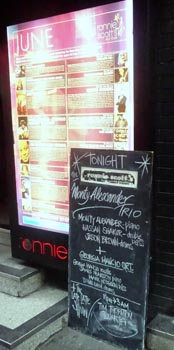 like Art Farmer, Bill Watrous, Charlie Rouse, Pepper Adams, Scott Hamilton and, of course, the best of British guys like Peter King, Stan Tracey and Don Weller.
like Art Farmer, Bill Watrous, Charlie Rouse, Pepper Adams, Scott Hamilton and, of course, the best of British guys like Peter King, Stan Tracey and Don Weller.
I have loved Jamaican-born pianist Monty Alexander for over 40 years ever since I was absolutely blown away by the LP, We’ve Only Just Begun, featuring his best-ever backing duo - Eugene Wright (bass) and Bobby Durham (drums). That trio had the lot - technique in abundance, togetherness and transmitted a feeling of joy in every bar they played. So when I heard that Monty was doing a spell at Ronnie’s, I decided to go for a double - hear him live for the first time and make a long overdue visit to Frith Street.
The club has, of course, changed considerably in recent years since it was taken over in 2006, expanded and adopted a broader musical policy although the shades of Ronnie and his partner, Pete King, still hover in the background. Even the ghost of Jim Godbolt, keen-eyed like a heron in the reeds, shimmered at the bar. And it’s no good turning up on the night for a popular artist like Monty, paying your dosh and just wandering in. When I booked on-line, Monty’s sessions were nearly sold-out so I had to be satisfied with a restricted view seat. I had been informed that Monty would do two sets with a break, starting at 8:15 so I checked in at 7:45 and was surprised to find that the place was already full and my seat on a four-person bench was second along, meaning that a punter chomping at his dinner had to move into the aisle to let me in.The view wasn’t really restricted but my reasonably sized body certainly was, jammed between the chomper and an elderly couple also eating but in a more decorous manner.
I also discovered that Monty was only doing one set starting at around nine o’clock but in the meantime there was a first-class backing band which included the outstanding pianist James Pearson who is always a pleasure to hear. Apart from these very minor niggles everything about Ronnie’s was perfect - the view, the sound quality, the reasonable admission price and an excellent small carafe of Fleurie served by one of the pleasant and efficient waiting staff.
Soon, Monty’s bass man, Hassan Shakur and drummer, Jason Brown, were set up and from rear-stage, emerged Monty, now in his early ‘70s, elegant and jovial. The trio launched into Too Marvellous For Words (click here for them playing it in 2014) and it was an absolute delight to hear, what is for this listener, one of the bedrocks of jazz, a swinging piano trio demonstrating their class with 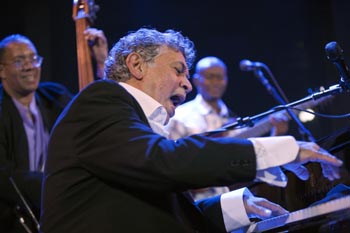 effortless ease. As the evening progressed, Monty proceeded to demonstrate that although he is able to swing his butt off, he can also do a mean ballad with a gorgeous rendition of When I Grow to Old to Dream.
effortless ease. As the evening progressed, Monty proceeded to demonstrate that although he is able to swing his butt off, he can also do a mean ballad with a gorgeous rendition of When I Grow to Old to Dream.
Although he left his home town of Kingston, Jamaica, as a very young man, Monty has never lost his lilting accent and between numbers kept us amused with gags and anecdotes. He’s probably said it a million times but towards the end he announced: “Thank-you for being a wonderful audience, ladies and gentlemen, and it is fantastic to be here in the greatest jazz club in the world, Ronnie Scott’s,’” and then as a mischievous aside “…I said that at the Blue Note two weeks ago.” That really brought the house down. He reminded us of his West Indian roots with a stunning Don’t Stop The Carnival which moved from calypso into hard swinging 4/4. I had heard him do that on video but live it was unbelievably good. The trio continually interacted with grins, laughter and joshing, reminding the audience of what a wonderful experience playing, listening to and watching jazz of the highest calibre can be.
Monty and his companions embodied joy and exuberance, combined with effortless skill and they took the audience with them. When it comes to jazz piano genius, Art Tatum passed the baton to Oscar Peterson who passed it on to Monty Alexander. An unforgettable evening.
Click here for a video of Monty Alexander playing Just In Time in 1978.
Jamie Evans (June 2016)
These reviews are the personal impressions/opinions of each reviewer.
© Sandy Brown Jazz